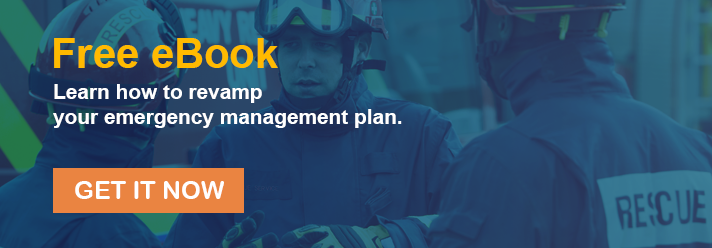When was the last time you reviewed your emergency management plan?
You probably have one sitting on the shelf somewhere collecting dust…but what good is that doing you?
You might be wondering:
“Does my team really know what to do in the event of adverse weather? How would they handle a bomb threat? How is everything communicated to my need-to-know staff?”
Are you using an incident management system to organize, track and manage your high priority issues?
Sure, these protocols are organized and outlined in your emergency management plan binder. Every protocol you’ve established is well written with a complete list for each issue and incident related to your venue.
You even do an annual training workshop for new and returning staff that includes role-playing to perfect response times.
We get it.
But here’s the problem:
When your busy team gets an unexpected call for a bomb threat or that there’s severe weather approaching – are they ready to respond effectively, efficiently and expeditiously?
Do you as a leader have peace of mind knowing that in a real emergency your team can and will execute according to your emergency management plan?
You’d better keep reading if you rely on your staff to run and grab the emergency binder when something serious occurs. And if your protocols aren’t automated either – keep reading!
An Incident Management System is the Missing Link
Your emergency management plan contains the breakdown for all your protocols to handle issues and incidents at your venue.
You’d probably like to have this information communicated effectively to your staff when they need it most, right?
Here’s what you need to understand:
Giving your staff the ability to communicate effectively and efficiently is the ultimate goal.
Now, in order to gain real-time data and have communication throughout all your departments, you must put an incident management infrastructure in place.
Real-time communication is the only way to receive real-time data. It’s vital in an emergency.
An incident management system is what gives you essential information. Supplementing it with mobile hand-held apps will help your command center broadcast protocols to handle – when they need to be handled – and how you need them to be handled.
Your front-line staff can report incidents in seconds directly into your incident management system.
What’s the best part?
The system isn’t purely capturing the incident. It captures all of the actions associated with that incident and communicates proper protocols to your emergency response teams.
Frequent incidents pose a challenge in operations. Emergencies cannot, because there’s absolutely no room for error. Your incident management infrastructure is imperative!
Consider this:
Severe weather is approaching.
Lightning is showing on the radar 14 miles out. You need to immediately communicate to all your departments.
Timing is everything when it comes to the safety of your patrons. With enhanced communication you’ll be able to quickly let your staff know it’s time to execute the adverse weather protocols.
Have the protocols ready for your staff, because none of them have time to scan through a comprehensive binder.
Does your operation have protocols in place for adverse weather conditions? If not, this will help.
Include Protocols for Adverse Weather Conditions in Your Emergency Management Plan
Event or Game Day
- Upon determining that weather conditions threaten the safety of patrons and participants at an event, your Command Post operator will contact the Manager on Duty and/or the Incident Management Team and the Event Promoter (if time permits) to advise accordingly.
- The Command Post will advise the police department and event security to prepare to assist patrons to move under shelter or to evacuate.
Move Your Patrons under Shelter
- A public announcement will inform the patrons of the impending situation and their option to leave the venue.
- Patrons will be advised of safe areas to seek shelter in the venue should such areas be available.
Use this Evacuation Order
A public announcement will notify patrons that a report of pending weather problems requires the event be canceled.
- Upon notice of evacuation, all security, ushers, maintenance, police, and fire rescue personnel shall go to their assigned evacuation posts.
- All food and merchandise vendors shall close their stands, secure their inventory and lock their cash drawers. Upon stand closure, all vendors shall exit the venue to a specific location and assemble for headcount.
Station Event Staffing and Security Personnel at Gates
- Proceed to assigned gates as if the event were about to end, and open the gates. If a gate key is not available, one can be obtained from the event staff supervisor.
- Ensure that all gates are open. All turnstiles should be closed.
- Direct patrons out of the venue and make sure that patrons do not re-enter the venue.
Ushers Stationed at the Concourse
- Position themselves near each exit from the seating areas as if the event were about to end, and assist in directing patrons out of the venue to the closest exit as quickly and efficiently as possible.
- Upon being relieved, reassemble with supervisor at a specific location for headcount. Attendance will be taken.
Ushers Stationed at Ramps and Elevators
- Position themselves at each exit to the ramps as if the event were about to end, and assist in directing patrons out of the venue as quickly and efficiently as possible.
- Calmly advise exiting patrons that the escalators will not be working during an evacuation. The ramps must be used.
Ushers Stationed in Seating Areas
- Respond to the front of your section as if the event has ended.
- Direct patrons out of their seating area toward the nearest exit as quickly and efficiently as possible.
- Assist the handicapped.
- Advise any handicapped in your area that in case of an evacuation, the elevators will not be in service.
Event Staffing and Security Stationed on the Field
- Assist the police department with escorting officials from the field.
- Secure all playing field entrances to ground level tunnel.
- Ensure that no one is allowed to re-enter the playing field except authorized personnel.
- Upon all personnel and officials exiting the venue, and being relieved, reassemble with your supervisor for headcount.
Parking Operations
- Parking operations should prepare to open all exit gates as if event has ended.
- Parking operations should stand by for directives from the command post concerning blocking off gate(s) and sections of the venue perimeter road for use by emergency vehicles.
- Upon all spectator vehicles leaving the venue, parking operations will reassemble with supervisors for headcount.
How impressed will your patrons be when you execute these protocols in a professional, seamless manner? They’ll feel safe and secure during the entire process.
Now:
Where adverse weather conditions are present, so are puddles and wet spots.
Use your incident management system to implement adverse weather protocols so your patrons are safe and you have peace of mind.
Well-Trained Staff and Incident Management Produce an Effective Strategy
To be ready for anything, it’s important for you to get your emergency management strategy into motion with a well-trained and high performing team.
You've got new and returning staff, right?
Position yourself as a credible leader by setting your team up for success.
Help them develop the know-how to mitigate incidents like adverse weather and bomb threats that might occur at your venue.
Integrate role-playing techniques into your training process too.
Create a role-playing process for returning, new and temporary staff to bring together important policies and processes from your emergency management strategy into tabletop scenarios where staff can learn what you need them to do.
Even better?
How you need them to do it!
Ask questions like this:
- Does your team have the awareness needed to identify potential hazards?
- What if a suspicious person or package appeared at your venue? How does your team handle this?
- Do they have the training and ability to handle a bomb threat professionally and in a way that your patrons don’t feel the effects?
In the end…you want to deliver an exceptional customer experience!
Do you have bomb threat protocols put in place at your venue?
We've put protocols together for you. Whether you have an existing plan in place or are starting from scratch, we encourage you to use these to gauge where your operation measures up.
But here’s the kicker:
You need to practice the steps with your staff so that everyone’s prepared to deliver a safe and secure experience for patrons.
Role-Play Bomb Threat Protocols with Your Team
- All bomb threats received at your venue must be reported immediately to the command post and venue management. If the bomb threat is received during an event, the command post will inform the Manager on Duty and/or the Incident Management Team, and the Command Officers from the police department and fire rescue.
- If a bomb threat is phoned in, the recipient of the threat must keep possession of a bomb threat information sheet until it is given to the appropriate official.
- If the bomb threat is received in written format, all materials (envelope, box, etc.) received along with the threat must be maintained and turned over to the appropriate official.
- If the bomb threat is personally reported by an individual, officials will be requested to the location of the reporting person.
- All information known about the bomb threat will be reviewed by commanders from the police department and fire rescue, in conjunction with the Manager on Duty and/or members of the Incident Management Team.
- The decision to conduct a full or partial evacuation of the entire venue will be a collaborative effort by the members of the police department, fire rescue and the Incident Management Team.
Bomb Search Guidelines
- If approved, venue personnel who are familiar with the area(s) of search should be utilized to search designated area(s).
- Rooms and enclosed area searches should be made with two person search teams who divide the area into search zones by both height and floor area.
- Search teams should look for unusual objects, a package similar to one that might have been described in the conversation with the telephone caller; or a package whose origin is questionable and/or suspicious in nature. Do not touch or disturb such objects.
- Upon completion of search of each area, the Command Post should be notified who will note completion of each area's search.
Over to You
OK. You’ve really made some use of your emergency management binder, imported protocols to handle into your incident management system and trained your staff…
Are you ready for the peace of mind you might not have achieved last year?
Obviously, the importance of having an emergency management strategy in place and working is vital.
Now ask yourself, are you ready for what’s coming?




